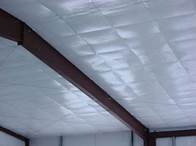When people think about insulation, words like “energy efficiency,” “thermal protection,” and “energy savings” usually come to mind. But let’s be honest — no one gets excited about how insulation looks. Unless, of course, we’re talking about white vinyl faced fiberglass insulation. Keep in mind that unless you intend to cover the insulation, you will be looking at it for a long time! Wouldn’t it be wise to install a glossy white attractive lining then?
Insulation can look good; WMP VR-R, WMP-10, WMP-30, and WMP-50 black or white vinyl faced fiberglass insulation proves it.
Let’s explore why contractors, architects, and savvy property owners choose white-faced fiberglass over other options — and how a little bit of white can go a long way.
A Bright Finish That That Everyone Appreciates

There’s something about a clean, white surface that makes a space feel more professional. Whether you’re working on a warehouse, gymnasium, metal building, or even an exposed ceiling in a commercial space — that bright, white vinyl facing offers a sleek, finished look that kraft paper or foil can’t match. Warehouses, mechanical rooms, gymnasiums, metal buildings, and agricultural facilities all deserve a little pop for their look.
No dark corners, rough textures — just clean lines and a surface reflecting light into the space. It’s like the difference between a bare-bulb garage and a showroom.
Reinforced vinyl Fiberglass offers tear resistance, too!

Let’s not forget—good looks come with solid performance. Again, the reinforced vinyl fiberglass facing acts as a vapor barrier, helping protect against condensation and moisture buildup. That’s a huge deal in places like food storage, workshops, or high-humidity areas where mold is a major no-no.
And because it’s reinforced vinyl fiberglass, it is much easier to install than unfaced insulation, and it holds up well to wear and tear. Translation: your insulation won’t just look good on day one — it’ll still look great years later.
Great for Exposed Installations
Usually, reinforced vinyl fiberglass-metal building insulation or pole barn insulation isn’t hidden behind drywall. It’s right there for everyone to see. DIY consumers or contractors roll it over the metal purlins and girts or wood framing and pin it down when the sheeting is attached. Why install drywall in a storage, shop, or industrial building? In those cases, the white vinyl-reinforced face does triple duty: it insulates the space and protects the insulation while keeping it visually clean and uniform.
It doesn’t just “pass with a ‘C’ grade.” It enhances the space with an “A” performance.
Contractors know that clients appreciate a job that doesn’t just function well but looks intentional — and this kind of insulation delivers both.
Easy to Clean, Easy to Love
Here’s a bonus: The vinyl surface is smooth and wipeable. So, if you’re working in a dusty shop or an area prone to messes, a quick clean keeps it looking fresh. Use a rag or hose it off; you’re as good as new. Try doing that with exposed fiberglass or kraft paper facing.
Final Thoughts: Beauty Meets Brawn
Other insulation types are available, such as fiberglass blow-in, spray foam, and reflective on can consider. Sure, it’s all insulation, someone might say. But white vinyl faced fiberglass insulation is more than just material behind a wall—it’s a wise, stylish choice for spaces that perform and present well. You’ll be amazed how a clean look can positively influence the selling price!
It’s a small detail that makes a big difference, from warehouses to workshops to your home basement. There is a reason why white vinyl insulation is still the most popular insulation type for pole barns and metal buildings. Weigh out your options, and I’m sure you’ll see as I do; it’s a no-brainer!

